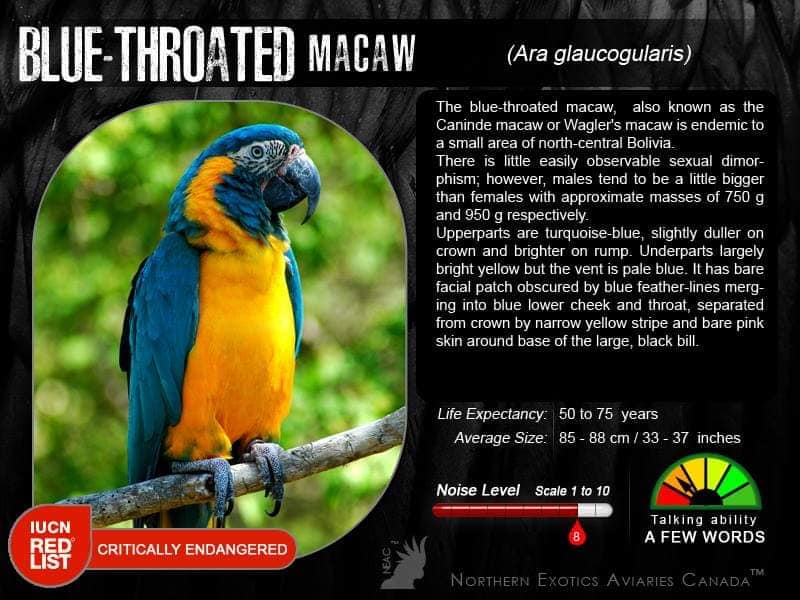Blue Throated Macaw - Ara Glaucogularis - Critically Endangered
The blue throated macaw (Ara glaucogularis; previously Ara caninde), also known as the Caninde macaw or Wagler's macaw, is a macaw endemic to a small area of north-central Bolivia, known as Los Llanos de Moxos. In 2014 this species was designated by law as a natural patrimony of Bolivia, where it is known as barba azul, which means 'blue beard' in Spanish. Recent population and range estimates suggests that about 350–400 individuals remain in the wild. The main causes of their demise is capture for the pet trade. It is currently considered critically endangered and the parrot is protected by trading prohibitions.
Description
The blue-throated macaw is about 85 cm (33 in) long including the length of its tail feathers and has a wingspan of approximately three feet or 0.9 m. It weighs about 900 g (32 oz) to 1,100 g (39 oz). There is little easily observable sexual dimorphism; however, males tend to be a little bigger than females with approximate masses of 750 g and 950 g respectively. Upperparts are turquoise-blue, slightly duller on crown and brighter on rump. Underparts largely bright yellow but the vent is pale blue. It has bare facial patch obscured by blue feather-lines merging into blue lower cheek and throat, separated from crown by narrow yellow stripe and bare pink skin around base of the large, black bill. On the face there is a sparsely feathered patch of skin near the base of the large dark-colored bill that has 5 or 6 horizontal stripes of blue feathers which are unique for every blue-throated macaw and can be used to individually identify adults.
The adults have yellow irises and the juveniles have brown irises. The eye color of a nestling is initially black and changes to brown soon after the eyes open. Between one and three years old, the eyes will turn grey, then white. As the macaw matures, the iris turns yellow and the amount of gold increases with age after 10 years. Elderly macaws show a ring of dark grey surrounding the pupil where the iris has become thinner and the back of the retina shows through. It can be separated from the slightly larger blue-and-yellow macaw by the blue (not black) throat, the blue (not green) crown and the lack of contrast between the remiges and upperwing coverts.
Distribution and Habitat
The blue-throated macaw lives in the Gran Chaco of the Beni Department of Bolivia, nesting in "Islas" (islands) of palm trees that dot the level plains. It is not a forest dwelling bird. This species is one of the rarest in the world, There are two areas inhabited by two sub-populations of Ara glaucogularis: one is to the northwest of Trinidad (the capital city of Beni), and the other is to the south of Trinidad. This complex landscape consists of grasslands, marshes, forest islands, and corridors of forests along waterways. They occur most often between the elevations of 200 and 300 m.
Behavior
Blue-throated macaws are most frequently found in monogamous pairs, but small groups of 7–9 do occur and one large roosting group of 70 is known. It is not known if these macaws will pair with another mate if their original mate dies. Their main mode of locomotion is flying, but they are also able to climb trees, maneuver along branches and walk on the ground. These birds are active during the day and usually stay in one general area. Blue-throated macaws communicate mostly by sound. When they suspect danger, they emit a very loud alarming call and promptly fly off. Blue-throated macaws are known to communicate with each other with quiet caws as well.
Aviculture
They are relatively easy to find in captivity, and the captive population consists of about 1000–1100 individuals.[11] Individuals are kept in several zoos around the World, among them the Santa Cruz zoo in Bolivia.
Several breeding and conservation schemes in zoos have now been set up to save this species. Other projects have been started to protect the remaining wild population, but at present numbers are still decreasing.
In the wild, within the palm groves of Bolivia, birds nest in tree hollows created in dead palm trunks, rotten knot-holes and dead limbs of trees. There is some evidence that parents maintain the third chick of a clutch with minimal food as an insurance against the loss of the older dominant chicks. If disaster should befall the larger chick the parent can switch to feeding the youngest and it will exhibit a constant growth curve from the day of active feeding. It is this physiological response that enables researchers to raise the third chick of a clutch in captivity and then return them to the wild nests when they are nearing fledge.
Blue-throated macaws are early nesters and utilize these rare resources of nest holes before the other macaws are in breeding condition.

Psittaciformes, The Parrot Index, a part of Phoenix Feathers © 2016 - 2024
Page last updated: 1/4/24
Phoenix Feathers

